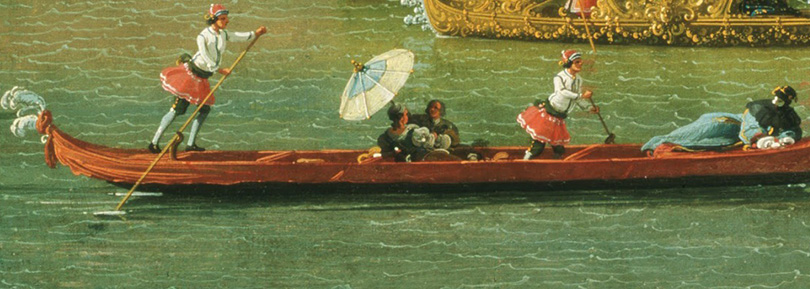Born: 17 October 1697
Venice
Died: 19 April 1768 (aged 70)
Venice
Nationality Italian
Known for: Landscape art, etching
Canaletto Paintings for Sale >>

The copyright of scripts in this website is owned by Toperfect. Toperfect reserves the manual scripts of original version. Toperfect will take appropriate legal action in the piracy and infringements of copyright.
Giovanni Antonio Canal (17 or 18 October 1697 – 19 April 1768), better known as Canaletto (Italian: [kanaˈletto]), was an Italian painter of landscapes, or vedute, of Venice. He was also an important printmaker in etching.
Canaletto, together with Giambattista Pittoni, Giovan Battista Tiepolo, Giovan Battista Piazzetta, Giuseppe Maria Crespi and Francesco Guardi forms the ultimate group of Venetian old master painters.
He was born in Venice as the son of the painter Bernardo Canal, hence his mononym Canaletto ("little Canal"), and Artemisia Barbieri. Bernardo Bellotto was his nephew and pupil. Canaletto served his apprenticeship with his father and his brother. He began in his father's occupation, that of a theatrical scene painter. Canaletto was inspired by the Roman vedutista Giovanni Paolo Pannini, and started painting the daily life of the city and its people.
After returning from Rome in 1719, he began painting in his topographical style. His first known signed and dated work is Architectural Capriccio (1723, Milan, in a private collection). Studying with the older Luca Carlevarijs, a moderately-talented painter of urban cityscapes, he rapidly became his master's equal.
In 1725, the painter Alessandro Marchesini, who was also the buyer for the Lucchese art collector Stefano Conti, had inquired about buying two more 'views of Venice', when the agent urged him to consider instead the work of "Antonio Canale... it is like Carlevaris, but you can see the sun shining in it."
Canaletto's early works remain his most coveted and, according to many authorities, his best. One of his early pieces is The Stonemason's Yard (1729, London, the National Gallery) which depicts a humble working area of the city.
Later Canaletto painted grand scenes of the canals of Venice and the Doge's Palace. His large-scale landscapes portrayed the city's pageantry and waning traditions, making innovative use of atmospheric effects and strong local colors. For these qualities, his works may be said to have anticipated Impressionism.
His graphic print S.A Giustina in Prà della Vale was found in the 2012 Nazi loot discovery.
After his return to Venice, Canaletto was elected to the Venetian Academy in 1763 and appointed prior of the Collegio dei Pittori. He continued to paint until his death in 1768. In his later years he often worked from old sketches, but he sometimes produced surprising new compositions. He was willing to make subtle alternations to topography for artistic effect.
Canaletto's views always fetched high prices, and as early as the 18th century Catherine the Great and other European monarchs vied for his grandest paintings. The record price paid at auction for a Canaletto is £18.6 million for View of the Grand Canal from Palazzo Balbi to the Rialto, set at Sotheby's in London in July 2005.
-- wikipedia
Home | About Toperfect Group | Contact Us | Terms & Copyrights
Powered by  Toperfect ([ˈtɔpəfikt]), Top & Perfect.
Toperfect ([ˈtɔpəfikt]), Top & Perfect.
Copyright © 1995 - . Toperfect is trademark of Toperfect Group.